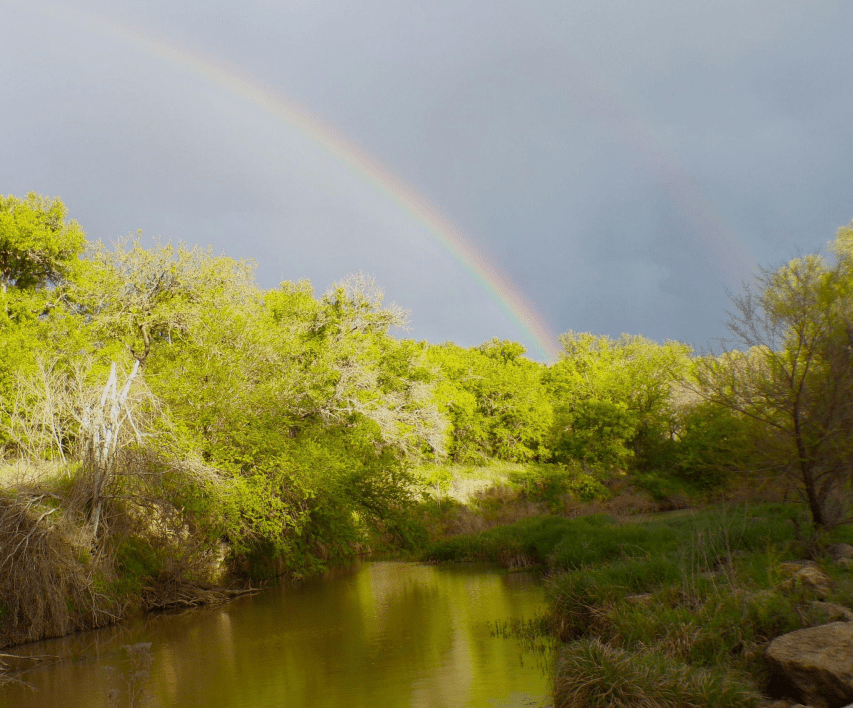
I love Jim Ned Creek in part because of the history that surrounds it. My husband and I like to go out to the crossing on the Grosvenor Road, where you can stop the car and get out to walk a bit along the bank. There’s been some good rain, and the sounds of the water gurgling and splashing as it winds through a culvert are soothing to me, like the presence of an old friend. There’s something about the sound of water that brings up memories, a sense of nostalgia, maybe even a connection to the past.
It’s Easter week, and to me that means a lot. Along the banks of the creek, clumps of wildflowers are growing, some I know, others I’ve never seen before. Just a few weeks ago, the grass was brown and faded, the tree branches bare and cold looking. In almost an instant, it seems like, the whole scene is changed. To me, this is an object lesson on the truth of resurrection, a promise that what is dead and gone is not truly lost forever. Nature itself teaches the truth of the story of Easter. I believe it.
Jim Ned was a Delaware chief, maybe a half-breed. He seemingly played both sides of the conflict between the settlers and the Comanche, acting at times as a guide for the Texans, at other times capturing unwary travelers and turning them over to Comanche Chief Santa Anna, who had his headquarters just south of the Santa Anna Mountains. Jim Ned lived, according to an article in Frontier Times magazine, right about where old Camp Colorado is now, near the Junction of Hord’s Creek and the Jim Ned Creek. He was said to be a quick-tempered man, supposedly responsible for the deaths of several Delaware tribesmen, which could be the reason why he lived a kind of shadow life, halfway between the Texans and the Native Americans, not fully a part of either group.
Jim Ned and his band must have moved on at some point, although there is no record I could find concerning when they may have left or where they might have gone. They lived for a time near Fort Graham and also in Wise County, but without dates it’s hard to say if this was before or after they lived here. Either way, for a time Jim Ned was a well known character on the frontier, befriended by some Texans, feared by others.
Jim Ned’s home, which later became Camp Colorado, was a military outpost on what was then the Texas frontier. During the mid 1800s, it was the center of activity for those attempting to settle in Brown County and surrounding areas. In the early days, whether you needed supplies, military protection or a place to meet pretty girls, Camp Colorado was where you had to go for those things. I imagine church services were held there at times as well. In his book, History of Brown County, Professor Havins recorded that the second known church in Brown County was a Methodist church along the Jim Ned Creek, just above the town of Thrifty.
Watching spring burst to life along Jim Ned gives me a sense of continuity and peace. Jim Ned and his family once roamed the banks of this creek. The children of the settlers that followed romped and splashed here as the warmth of the sun returned, and flowers lined the banks like they do today. Strains of an old fiddle playing a hymn in honor of resurrection day might have wafted down through the warming breeze over the burbling of the rain filled creek.
The people from the old stories are gone, and new people have come. The creek is up, filled with fresh spring rain. There is still a whisper of the older times here by the creek. Like the promise in the sunrise, the promise of the new leaves, waving in a hundred shades of glowing green overhead, a resurrection awaits us all. Nothing good is truly lost here, nothing is gone forever. One day all the ills and hurts, the wars and brutalities of the human race will be laid to rest, and the light we struggled to find will rise again. I can almost hear the refrain from some long ago pioneer Easter service carried downstream on the hum of the water, “He is risen! He is risen indeed.”
***
Diane Adams is a local journalist whose columns appear Thursdays on BrownwoodNews.com
